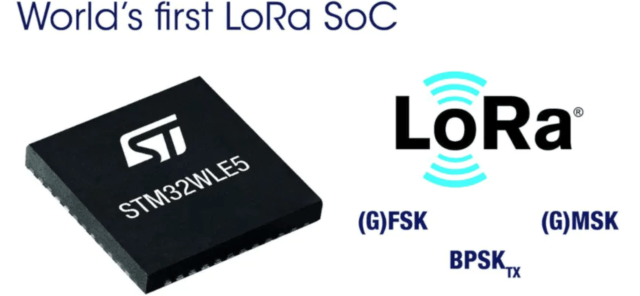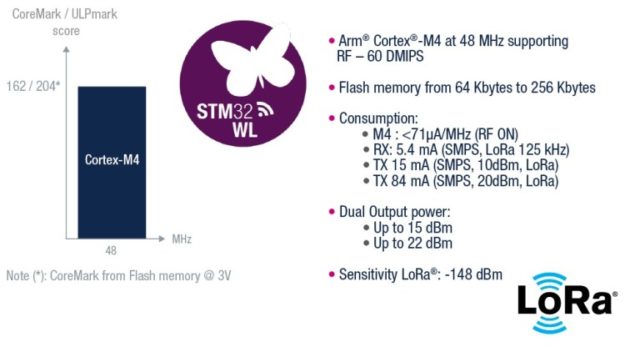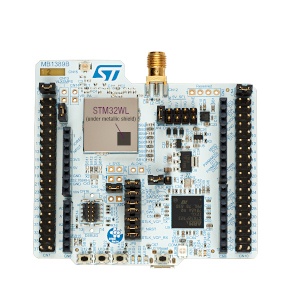There is no denying that the Internet of Things is going to disrupt a lot of markets and it’s already happening to some extent. The question being asked is: “What IoT connectivity technology will lead this disruption era?”. One major technology in this connectivity race is LoRa.
LoRa’s long-range, low-power, small footprint, simplicity, and the amazing community backing it, have allowed it to find its way into various applications while gaining for the top LPWAN IoT connectivity technology. STMicroelectronics, one of the biggest semiconductor manufacturer, also believes in the potential of LoRa with the launch of STM32WL, making it the World’s first die-integrated LoRa System-on-Chip.

Traditional LoRa embedded platforms usually involve the need for a separate MCU chip and different LoRa transceiver chips either coupled together in one single package or separately. This undoubtedly adds extra design complexity, size, and even cost. STMicro hopes to address this with their STM32WL SoC. This new device opens the door to original applications by enabling simpler, more flexible, more integrated, and more power-efficient designs.
The STM32WL SoC integrates both a general-purpose microcontroller and a sub-GHz radio based-on Semtech SX126x on the same chip. The STM32WL is based on the ultra-efficient STM32L4 series MCU. The SoC includes an Arm Cortex-M4 processor with a digital signal processor (DSP) and a memory protection unit (MPU) running at up to 48MHz. It comes with 64 KB/128 KB/256KB of flash memory and up to 64kB of RAM.
The STM32WL SoC is based on the Semtech SX126x IP, engineered with dual high-power and low-power transmitter modes covering the entire global sub-1GHz unlicensed frequency range from 150MHz to 960MHz. The integrated radio has sensitivity down to -148 dBm, with two embedded power amplifiers at 15dBm and 22dBm maximum Tx power. The radio supports (G)FSK, (G)MSK, and BPSK modulation

The SoC security features include hardware public key accelerator (PKA), True Random Number Generator (TRNG), sector protection against read/write operation (PCROP), and support for state-of-the-art cryptographic algorithms including RSA.
STMicro is proposing to use the STM32L4 Nucleo board and a Semtech expansion board such as the SX1262DVK1DAS, the SX1262DVK1CAS or the SX1262DVK1BAS for temporarily working with a platform similar to STM32WL. A development board might be coming out soon for prototyping directly with the STM32WL called the NUCLEO-WL55JC1, as shown on the blog post.

The device is ready for shipping to OEM with BGA housing, but more housing varieties are expected by the end of the year along with a Sigfox stack. No pricing information is currently available at this point.
More information is available on the product page and the press release.

I enjoy writing about the latest news in the areas of embedded systems with a special focus on AI on edge, fog computing, and IoT. When not writing, I am working on some cool embedded projects or data science projects. Got a tip, freebies, launch, idea, gig, bear, hackathon (I love those), or leak? Contact me.
Support CNX Software! Donate via cryptocurrencies, become a Patron on Patreon, or purchase goods on Amazon or Aliexpress





This is a bit misleading, there is also the Microchip SAM R34/R35 (https://www.microchip.com/design-centers/wireless-connectivity/low-power-wide-area-networks/lora-technology/sam-r34-r35) which is available since last year.
Apparently, the SAM R34/R35 is a System-in-Package while the STM32WL is a System-on-Chip. No much of a difference for the users of these solution, the footprint of the SAM R34/R35 is already tiny. The difference between these solutions will probably be in software support and maybe power efficiency.
Also covered here 🙂 https://www.cnx-software.com/2018/11/21/microchip-sam-r34-r35-lora-sip-development-kit/
SAm R34/R35 are not comparable to ST new chip. They are multi die including one semtech SX127x RF front end while the ST chip is single die and based on semtech SX126x which is more recent, more powerfull, and more energy efficient than SX127x.
there’s also ASR6501/ASR6502
And asr6505 why not… Admittedly not stm32, but cheaper….
https://github.com/asrlora/alios-asr-lora